|
Subaru R2
Debut: 2004
Maker: Subaru
Predecessor: no |
|
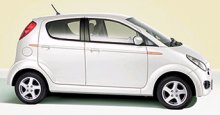 To
automotive journalists, Japanese K-cars are not very interesting to
write
about. Although it is the most popular category in Japan and there are
2 dozens of models from 5 manufacturers flooding over the market, most
K-cars are hardly distinguishable. Firstly, the size limit (3400mm long
and 1475mm wide) dictates their shape. They are therefore made as
square
as possible and have their wheels pushing towards the corners to
maximize
interior space. In this way, the creativity of designers is seriously
limited.
Secondly, the limitation of 660cc engine capacity leaves no space for
engineers
to explore new directions. All K-cars have similar engine format and
deliver
similar performance. If BMW were asked to develop a K-car, I suspect it
will be much the same as Suzuki or Daihatsu's offering, albeit the
double-kidney
grille. To
automotive journalists, Japanese K-cars are not very interesting to
write
about. Although it is the most popular category in Japan and there are
2 dozens of models from 5 manufacturers flooding over the market, most
K-cars are hardly distinguishable. Firstly, the size limit (3400mm long
and 1475mm wide) dictates their shape. They are therefore made as
square
as possible and have their wheels pushing towards the corners to
maximize
interior space. In this way, the creativity of designers is seriously
limited.
Secondly, the limitation of 660cc engine capacity leaves no space for
engineers
to explore new directions. All K-cars have similar engine format and
deliver
similar performance. If BMW were asked to develop a K-car, I suspect it
will be much the same as Suzuki or Daihatsu's offering, albeit the
double-kidney
grille.
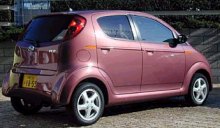 To
a small manufacturer like Subaru, falling into the same mould as the
giant
Suzuki and Daihatsu is not a good thing, because its smaller scale of
production
would lead to higher production cost, hence lower competitiveness. To
survive,
it must go the premium route, differing from other K-cars in appearance
and packaging. This task has been given to the company's foreign design
chief, Andreas Zapatinas. The Greek was renowned for designing Alfa
Romeo
145 and Fiat Barchetta in the last decade. Since joining Subaru in
2002,
he created a couple of concept cars, B9 roadster and B11S sports coupe,
both are radically styled by Japanese standard. However, his first
production
car would not be so easy, because it would be the replacement to Pleo,
Subaru's only K-car. Zapatinas intended to revolve the styling of
K-cars.
Can he succeed? To
a small manufacturer like Subaru, falling into the same mould as the
giant
Suzuki and Daihatsu is not a good thing, because its smaller scale of
production
would lead to higher production cost, hence lower competitiveness. To
survive,
it must go the premium route, differing from other K-cars in appearance
and packaging. This task has been given to the company's foreign design
chief, Andreas Zapatinas. The Greek was renowned for designing Alfa
Romeo
145 and Fiat Barchetta in the last decade. Since joining Subaru in
2002,
he created a couple of concept cars, B9 roadster and B11S sports coupe,
both are radically styled by Japanese standard. However, his first
production
car would not be so easy, because it would be the replacement to Pleo,
Subaru's only K-car. Zapatinas intended to revolve the styling of
K-cars.
Can he succeed?
 Look
at the pictures, I am convinced that his work pays off. This car is
called
R2 - the same as another Subaru mini car in the late 60s. It looks
nothing
like other K-cars, but more like a 5-door, 4-seat version of Smart
Fortwo,
which is of course a praise. Its monospace body is smooth and nicely
curved
- the well-chosen curvature prevents a boxy and bland shape found in
other
Japanese K-cars yet prevents the R2 from being too radical. Pronounced
wheelarches (like Smart again) deliver a sporty, planted feel. The R2
also
introduced a new corporate grille (first shown in B9 and B11S concept
cars),
giving the front end a more elegant visual effect. This design is
definitely
a success, giving R2 a unique image and a premium status over other
K-cars. Look
at the pictures, I am convinced that his work pays off. This car is
called
R2 - the same as another Subaru mini car in the late 60s. It looks
nothing
like other K-cars, but more like a 5-door, 4-seat version of Smart
Fortwo,
which is of course a praise. Its monospace body is smooth and nicely
curved
- the well-chosen curvature prevents a boxy and bland shape found in
other
Japanese K-cars yet prevents the R2 from being too radical. Pronounced
wheelarches (like Smart again) deliver a sporty, planted feel. The R2
also
introduced a new corporate grille (first shown in B9 and B11S concept
cars),
giving the front end a more elegant visual effect. This design is
definitely
a success, giving R2 a unique image and a premium status over other
K-cars.
The
achievement
of Zapatinas
also reminds me another foreign design chief in Japan, Olivier Boulay
of
Mitsubishi (now gone together with DaimlerChrysler). He changed the
scene
of Japanese mini cars by introducing the stylish new Colt. Obviously,
Japanese
car industry needs to hire more foreign designers. Unfortunately, they
are still reluctant to do so.
The
R2's body is
stretched
to the maximum limits for K-cars. It measures 3395mm in length, 1475mm
in width while the height is pushed to 1520mm. Without exceeding
1550mm,
it can be parked at tower parking which is popular in the crowded
cities
in Japan. Its wheelbase is 2360mm, slightly shorter than Daihatsu Mira
(Charade) (by 30mm) and Honda Life (by 60mm) but matches Suzuki's
various
K-cars. This means it is not going to offer the most rear legroom among
K-cars. Similarly, the curvy body eats a little bit shoulder room and
luggage
space. Never mind, BMWs also offer less room than rivals.
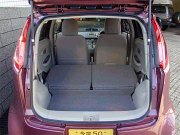 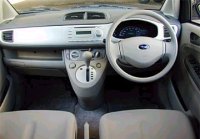 What
the Subaru beats its rival is the interior style and quality. Most
K-cars
employ hard plastics throughout the cabin. Many of them care more about
the number of storage cubbies and cup holders than style and quality.
In
contrast, R2 pays a lot of attention to the interior design and
trimming,
making it the most expensive-feeling K-car interior. In terms of
styling,
its instrument panel looks like that of Nissan Micra (March), which is
one of the most elegant dashboards in small cars. It is constructed in
high-quality plastics and, like the rest of the cabin, finished in
light
color scheme to please female buyers. Moreover, it does this without
sacrificing
functions. For example, the gear stick is mounted high at the center
console
for ease of use. There are a lot of storage cubbies. The rear bench is
50-50 split and can fold flat to store luggage. Although it is not the
most spacious K-car, it still offer a high degree of practicality. What
the Subaru beats its rival is the interior style and quality. Most
K-cars
employ hard plastics throughout the cabin. Many of them care more about
the number of storage cubbies and cup holders than style and quality.
In
contrast, R2 pays a lot of attention to the interior design and
trimming,
making it the most expensive-feeling K-car interior. In terms of
styling,
its instrument panel looks like that of Nissan Micra (March), which is
one of the most elegant dashboards in small cars. It is constructed in
high-quality plastics and, like the rest of the cabin, finished in
light
color scheme to please female buyers. Moreover, it does this without
sacrificing
functions. For example, the gear stick is mounted high at the center
console
for ease of use. There are a lot of storage cubbies. The rear bench is
50-50 split and can fold flat to store luggage. Although it is not the
most spacious K-car, it still offer a high degree of practicality.
Exterior
and
interior packaging
is definitely the strength of R2. Comparatively, mechanical is more
mainstream.
Like other K-cars, the R2 rides on strut and torsion-beam suspensions.
Front-wheel-drive is the default choice while 4WD is optional. 5-speed
manual gearbox is default, CVT is optional. Admittedly, if you buy the
Turbo version, it will come with a CVT providing a 7-speed manual mode.
That's perhaps the only unique feature.
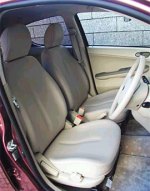 The
little heart of R2 displaces 0.66 litres, of course. While most rivals
employ 3 cylinders for lower cost and fuel consumption, R2 still employ
4 cylinders. Why? you may find the answer from its rivals. Suzuki, for
example, employs 3 cylinders for both the naturally aspirated and
turbocharged
engines, but the turbo is a light pressure turbo producing only 60ps
and
61 lbft of torque, even failing to reach the government limit of 64
horsepower.
In contrast, the turbocharged version of R2 produces a full 64ps and a
decisive 15 lbft more torque. Obviously, the imbalanced nature of
3-cylinder
engines prevents them from heavily turbocharged. No wonder Daihatsu
uses
4 cylinders for its powerful turbo engines and 3 cylinders for normally
aspirated engines. To Subaru, they cannot afford to develop and produce
2 engines, so they chose 4 cylinders. The
little heart of R2 displaces 0.66 litres, of course. While most rivals
employ 3 cylinders for lower cost and fuel consumption, R2 still employ
4 cylinders. Why? you may find the answer from its rivals. Suzuki, for
example, employs 3 cylinders for both the naturally aspirated and
turbocharged
engines, but the turbo is a light pressure turbo producing only 60ps
and
61 lbft of torque, even failing to reach the government limit of 64
horsepower.
In contrast, the turbocharged version of R2 produces a full 64ps and a
decisive 15 lbft more torque. Obviously, the imbalanced nature of
3-cylinder
engines prevents them from heavily turbocharged. No wonder Daihatsu
uses
4 cylinders for its powerful turbo engines and 3 cylinders for normally
aspirated engines. To Subaru, they cannot afford to develop and produce
2 engines, so they chose 4 cylinders.
The
little 4-pot
engine has
3 stage of tune: the base version is normally aspirated, with a
single-cam
and 8-valve cylinder head to produce 46 horsepower. The second version
is also normally aspirated, with twin-cam 16 valves and AVCS variable
valve
timing to produce 54 horsepower. This is likely to be the best seller.
The hottest is the turbocharged version of the 16V but have the AVCS
discarded.
It makes 64 horsepower and a useful 76 lbft of torque. This is
currently
the most torquey engine in the K-car world.
Subaru
R2 is a
premium K-car.
Its superior style and quality also bring a higher price tag. In Japan,
it is about 20% more expensive than an equivalent Daihatsu Mira, our
current
pick of the class. That place it straight into the higher segment
(Nissan
March, Toyota Passo etc.). That's probably the biggest problem it
faces.
Although buying a K-car has advantages in tax and warrant fees, whether
it make sense compare with a properly sized and properly engined car is
debatable. One thing is for sure, this good-looking, high-quality mini
car will be seen as a niche car and get many fans. |
| The
above report was last updated on 20 Aug
2004. All Rights Reserved. |
R1
|
 Most
Japanese car makers try hard to maximize the space of their K-cars,
pushing
them right to the limits allowed by the law and making them as square
as
possible. The result is a bland and "me-too" shape. Most
Japanese car makers try hard to maximize the space of their K-cars,
pushing
them right to the limits allowed by the law and making them as square
as
possible. The result is a bland and "me-too" shape.
Subaru
R2 is by no means "me-too", but compare with Smart Fortwo it is
obviously
less interesting. Therefore, based on the R2 architecture, Subaru
developed
an even smaller and nicher car called R1. It appeals to the same crowd
as the Smart - those single, yuppie and fun-seeking young people. Its
selling
point is a lovely bubble shape which is inspired by beetles (I mean the
insect, not the Volkswagen), and a more colorful cabin.
 The
R1 is a 3-door mini-hatch intended to carry 2 people only. Compare with
R2, its length is cut by 110mm and wheelbase is 165mm shorter. That put
it at an even lower category than the K-cars, although it actually
sells
at a rather premium price. Its 2-ton cabin with leather seats is more
luxurious
than the R2. The tiny rear seats can sit children or simply fold down
to
place shopping bags. The
R1 is a 3-door mini-hatch intended to carry 2 people only. Compare with
R2, its length is cut by 110mm and wheelbase is 165mm shorter. That put
it at an even lower category than the K-cars, although it actually
sells
at a rather premium price. Its 2-ton cabin with leather seats is more
luxurious
than the R2. The tiny rear seats can sit children or simply fold down
to
place shopping bags.
Subaru
is not greedy. It just wants to sell 10,000 R1s a year. To justify the
cost, all mechanicals are shared with the R2, including engine,
transmission,
suspensions and steering. |
| The
above report was last updated on 3 Feb 2005. All
Rights Reserved. |
|
|